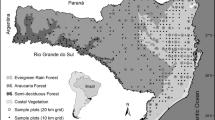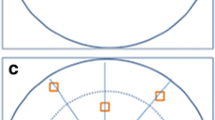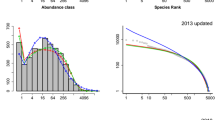Abstract
We used survey data collected from a large plot (20 ha) of sub-tropical forest in the Dinghushan Nature Reserve, Guangdong Province, southern China, in 2005 to test the comparative performance of nine species-richness estimators (number of observed species, three species-individual curve models, five nonparametric estimators). As the true species richness, we used the 210 free-standing shrub and tree species of >1 cm diameter at breast height recorded during the survey. This true species richness was then used to calculate performance measures of bias, accuracy, and precision for each estimator, whereby we distinguished performance for low, medium, and high sampling intensity. Unsurprisingly, all estimators performed better than the number of observed species in terms of bias and accuracy. Surprisingly, however, two curve models (logistic and logarithm) outperformed all other estimators in terms of bias, accuracy, and precision, which is in contrast to most other previous studies, in which nonparametric methods usually outperform curve models. Intriguingly, relative estimator performance changed between low, medium, and high sampling intensity, sometimes dramatically, reinforcing the assertion that the influence of sampling intensity on estimator performance is an important aspect to investigate and to consider when choosing estimators for ecological surveys. Because these results are based on only one dataset, the results should be treated with caution, both because (1) the generality of these results needs to be confirmed with simulated datasets and (2) more work is needed to establish what “true” species richness is extrapolated by each of the tested estimators in both the statistical and the practical sense. Nevertheless, the two curve estimators, namely Logistic and Logarithm, should be considered in future studies of comparative performance of species-richness estimators because of their outstanding performance in this study.



Similar content being viewed by others
References
Archibald EEA (1949) The specific character of plant communities: II a quantitative approach. J Ecol 37:274–288
Arrhenius O (1921) Species and area. J Ecol 9:95–99
Arrhenius O (1923) Statistical investigations in the constitution of plant associations. Ecology 4:68–73
Baltanás A (1992) On the use of some methods for the estimation of species richness. Oikos 65:484–492
Boecklen WJ, Gotelli NJ (1984) Island biogeographic theory and conservation practice: species-area or specious-area relationships? Biol Conserv 29:63–80
Brose U, Martinez DN (2004) Estimating the richness of species with variable mobility. Oikos 105:292–300
Burnham KP, Overton WS (1978) Estimation of the size of a closed population when capture probabilities vary among animals. Biometrika 65:623–633
Burnham KP, Overton WS (1979) Robust estimation of the size of population size when capture probabilities vary among animals. Ecology 60:927–936
Chao A (1984) Nonparametric estimation of the number of classes in a population. Scand Stat Theory Appl 11:265–270
Chao A (1987) Estimating the population size for capture-recapture data with unequal catchability. Biometrics 43:783–791
Chazdon RL, Colwell RK, Denslow JS, Guariguata MR (1998) Statistical methods for estimating species richness of woody regeneration in primary and secondary rain forests of northeastern Costa Rica. In: Dallmeier F, Comiskey JA (eds) Forest biodiversity research, monitoring and modeling: conceptual background and Old World case studies. Parthenon Publishing Group, Carnforth, pp 285–309
Chiarucci A, Enright NJ, Perry GLW, Miller BP, Lamont BB (2003) Performance of nonparametric species richness estimators in a high diversity plant community. Divers Distrib 9:283–295
Colwell RK, Coddington JA (1994) Estimating terrestrial biodiversity through extrapolation. Philos Trans R Soc Lond B Biol Sci 345:101–118
Condit R, Hubbell SP, Lafrankie JV, Sukumar R, Manokaran N, Foster RB, Ashton PS (1996) Species-area and species-individual relationships for tropical trees: a comparison of three 50-ha plots. J Ecol 84:549–562
de Candolle A (1855) Géographie botanique raisonnée: ou. Exposition des faits principaux et des lois concernant la distribution géographique des plantes de l’epoque actuelle. Masson, Paris
Efron B (1979) Bootstrap methods: another look at the jackknife. Ann Stat 7:1–26
Efron B, Thisted R (1976) Estimating the number of unseen species: how many words did Shakespeare know? Biometrika 63:435–447
Evans FC, Clark PJ, Brand RH (1955) Estimation of the number of species present on a given area. Ecology 36:342–343
Gimaret-Carpentier C, Pelissier R, Pascal JP, Houllier F (1998) Sampling strategies for the assessment of tree species diversity. J Veg Sci 9:161–172
Gleason HA (1922) On the relation between species and area. Ecology 3:158–162
Gleason HA (1925) Species and area. Ecology 6:66–74
Grassle JF, Maciolek NJ (1992) Deep-sea species richness: regional and local diversity estimates from quantitative bottom samples. Am Nat 139:313–341
He FL, Legendre P, LaFrankie JV (1996) Spatial pattern of diversity in a tropical rain forest in Malaysia. J Biogeogr 23:57–74
Heltshe JF, Forrester NE (1983) Estimating species richness using the jackknife procedure. Biometrics 39:1–11
Hubbell SP, Foster RB (1983) Diversity of canopy trees in a Neotropical forest and implications to conservation. Blackwell, Oxford
Jaccard P (1902) Lois de distribution florale dans la zone alpine. Bull Soc Vaudoise Sci Nat 38:69–130
Jaccard P (1908) Nouvelles recherches sur la distribution florale. Bull Soc Vaudoise Sci Nat 44:223–270
Keating KA, Quinn JF (1998) Estimating species richness: the Michaelis–Menten model revisited. Oikos 81:411–416
Kilburn PD (1966) Analysis of the species-area relation. Ecology 47:831–843
Loehle C (1990) Proper statistical treatment of species-area data. Oikos 57:143–145
Mo J, Zhang W, Zhu W, Gundersen P, Fang Y, Li D, Wang HI (2008) Nitrogen addition reduces soil respiration in a mature tropical forest in southern China. Glob Chang Biol 14:403–412
Norris JLIII, Pollock KH (1996) Nonparametric MLE under two closed capture-recapture models with heterogeneity. Biometrics 52:639–649
Palmer MW (1990) The estimation of species richness by extrapolation. Ecology 71:1195–1198
Palmer MW (1991) Estimating species richness: the second-order jackknife reconsidered. Ecology 72:1512–1513
Palmer MW (1995) How should one count species? Nat Area J 15:124–135
Palmer MW, Earls PG, Hoagland BW, White PS, Wohlgemuth T (2002) Quantitative tools for perfecting species lists. Environmetrics 13:121–137
Rey-Benayas JM, Scheiner SM (2002) Plant diversity, biogeography and environment in Iberia: patterns and possible causal factors. J Veg Sci 13:245–258
Skov F, Lawesson JE (2000) Estimation of plant species richness from systematically placed plots in a managed forest ecosystem. Nord J Bot 20:477–483
Smith EP, van Belle G (1984) Nonparametric estimation of species richness. Biometrics 40:119–129
Ugland KI, Gray JS, Ellingsen KE (2003) The species-accumulation curve and estimation of species richness. J Anim Ecol 72:888–897
Walther BA, Martin JL (2001) Species richness estimation of bird communities: how to control for sampling effort? Ibis 143:413–419
Walther BA, Moore JL (2005) The concepts of bias, precision and accuracy, and their use in testing the performance of species richness estimators, with a literature review of estimator performance. Ecography 28:815–829
Walther BA, Morand S (1998) Comparative performance of species richness estimation methods. Parasitology 116(Pt 4):395–405
Zelmer DA, Esch GW (1999) Robust estimation of parasite component community richness. J Parasitol 85:592–594
Zhou G, Liu S, Li Z, Zhang D, Tang X, Zhou C, Yan J, Mo J (2006) Old-growth forests can accumulate carbon in soils. Science 314:1417
Acknowledgments
The authors acknowledge the Chinese Forest Biodiversity Monitoring Network, the Knowledge Innovation Project of The Chinese Academy of Sciences (KZCX2-YW-430), and the National Key Technology R&D Program (2008BAC39B02) for financial support of this research work. The Biodiversity Committee and the Bureau of Science and Technology for Resources and Environment of the Chinese Academy of Sciences facilitated the plot establishment through financial assistance. The authors also thank the assistance of a number of colleagues and hired helpers who assisted in field-data collection and species identification. Dr. Xinsheng Hu, Professor Shenglei Fu, and two anonymous referees reviewed this study and made valuable suggestions. Professor Fangliang He of the University of Alberta, Professor Yifang Sun of the TunHai University, Dr. Richard Condit of the CTFS, and Dr. Pierre Legendre of the University of Montreal assisted with data analysis training.
Author information
Authors and Affiliations
Corresponding author
About this article
Cite this article
Wei, Sg., Li, L., Walther, B.A. et al. Comparative performance of species-richness estimators using data from a subtropical forest tree community. Ecol Res 25, 93–101 (2010). https://doi.org/10.1007/s11284-009-0633-2
Received:
Accepted:
Published:
Issue Date:
DOI: https://doi.org/10.1007/s11284-009-0633-2




